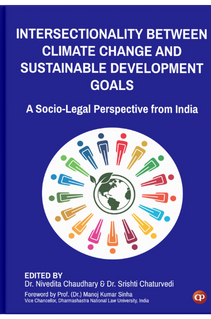Envisioning the 1.5˚C Lifestyle: New Approach Towards Sustainable Fashion Communication

by Dr. Pooja Kiyawat1 & Dr. Ankit Singh2
1Assistant Professor, Cyber Law and Information Security, National Law Institute University, Bhopal, India; 2Assistant Professor of Law, DPIIT-IPR Chair Professor, Head- Centre for Innovation and IP Laws (CIIPL), Hidayatullah National Law University, Raipur, India.
10.46679/9788196780524ch16
This chapter is a part of: Intersectionality Between Climate Change and Sustainable Development Goals: A Socio-Legal Perspective from India
ISBN (Ebook):978-81-967805-2-4
ISBN (Hardcover Print):978-81-967805-0-0
ISBN (Softcover Print):978-81-967805-3-1
© CSMFL Publications & its authors.
Published: August 28, 2025
https://dx.doi.org/10.46679/9788196780524ch16
Abstract
The authors explore innovative strategies to align fashion communication with the urgent need for climate action. The chapter seeks to examine the recently released Sustainable Fashion Communication Playbook by the United Nations Environment Programme (UNEP), assessing its effectiveness and proposing enhancements to foster a 1.5°C lifestyle—a benchmark set by the Paris Agreement to limit global warming. The chapter highlights the potential of fashion as a powerful cultural force capable of driving significant behavioural changes towards sustainability. By dissecting the Playbook, it identifies key strengths, such as its emphasis on transparency, circular economy, and stakeholder collaboration. However, it also critiques areas where the Playbook falls short, such as insufficient attention to consumer engagement and the lack of actionable guidelines for small to medium enterprises. Through a comprehensive review, the chapter suggests a new framework that integrates cutting-edge communication theories, digital tools, and community-based approaches. This framework aims to empower consumers, brands, and policymakers to co-create a sustainable fashion narrative that not only raises awareness but also motivates concrete actions. Ultimately, this chapter argues for a transformative shift in how the fashion industry communicates sustainability, advocating for a holistic approach that embeds environmental consciousness into every facet of the fashion lifecycle. By envisioning and implementing a 1.5°C lifestyle, the fashion sector can play a pivotal role in achieving global climate goals and fostering a more sustainable future.
Keywords: Sustainability, Fashion Communicators, Climate Change.
References
- United Nations Environment Programme. (2022). The Sustainable Fashion Communication Playbook. UNEP. https://www.unep.org/resources/publication/sustainable-fashion- communication-playbook.
- Ellen MacArthur Foundation. (2017). A new textiles economy: Redesigning fashion’s future. Ellen MacArthur Foundation.
- United Nations Framework Convention on Climate Change. (2015). The Paris Agreement. UNFCCC.
- Institute for Global Environmental Strategies. (2019). 1.5-Degree Lifestyles: Targets and options for reducing lifestyle carbon footprints. IGES. https://www.iges.or.jp/en/pub/15-degrees-lifestyles-2019/en.
- United Nations. (2015). Transforming our world: The 2030 Agenda for Sustainable Development. UN.
- Secretariat of the Basel Convention. (2019). Basel Convention on the Control of Transboundary Movements of Hazardous Wastes and Their Disposal. UNEP.
- French Government. (2020). Anti-Waste and Circular Economy Law. https://entreprendre.service-public.fr/vosdroits/F37829.
- State of California Department of Justice. (2010). The California Transparency in Supply Chains Act. https://oag.ca.gov/SB657.
- Netherlands Authority for Consumers and Markets. (2022). Going forward, Decathlon and H&M will provide better information about sustainability to consumers. https://www.acm.nl/en/publications/going-forward-decathlon-and- handm-will-provide-better-information-about-sustainability-consumers.
- Petty, R. E., & Cacioppo, J. T. (1986). Communication and persuasion: Central and peripheral routes to attitude change. Springer-Verlag.
- Bandura, A. (1986). Social foundations of thought and action: A social cognitive theory. Prentice-Hall.
- Rogers, E. M. (1962). Diffusion of innovations. Free Press.
- Thaler, R. H., & Sunstein, C. R. (2008). Nudge: Improving decisions about health, wealth, and happiness. Yale University Press.
- Kahneman, D., & Tversky, A. (1979). Prospect theory: An analysis of decision under risk. Econometrica, 47(2), 263-291.
- Freeman, R. E. (1984). Strategic management: A stakeholder approach. Pitman.
- Organisation for Economic Co-operation and Development. (1972). Recommendation of the Council on Guiding Principles Concerning International Economic Aspects of Environmental Policies. OECD. https://legalinstruments.oecd.org/en/instruments/11
- Global Fashion Agenda. (n.d.). Pulse of the Fashion Industry. https://globalfashionagenda.org/resource/pulse-of-the-fashion-industry-2017/
- United Nations Environment Programme. (n.d.). Sustainable Consumption and Production Hotspots Analysis Tool (SCP-HAT). https://scp-hat.org/.
- European Union. (2016). General Data Protection Regulation (GDPR).
- Ministry of Electronics and Information Technology, Government of India. (2023). Digital Personal Data Protection Act 2023.
- United Nations Climate Change. (2021). Fashion Industry Charter for Climate Action. https://unfccc.int/climate-action/sectoral-engagement-for-climate- action/fashion-charter.
- Ellen MacArthur Foundation. (n.d.). Circular Economy in Fashion – Deep Dive. https://www.ellenmacarthurfoundation.org/fashion-and-the-circular-economy- deep-dive.
- McKinsey & Company. (2023). Sustainable style: How fashion can afford and accelerate decarbonization. https://www.mckinsey.com/industries/retail/our- insights/sustainable-style-how-fashion-can-afford-and-accelerate-decarbonization
- European Commission. (2022). Proposal for a Directive on Green Claims. https://environment.ec.europa.eu/eu-green-deal/green-claims_en
- Ellen MacArthur Foundation. (n.d.). Circular Economy in Fashion. https://www.ellenmacarthurfoundation.org/topics/fashion/overview
- European Commission. (2022). EU Strategy for Sustainable and Circular Textiles. https://environment.ec.europa.eu/strategy/sustainable-and-circular-textiles_en.
This book is available worldwide via EBSCOhost Academic Collection, EBSCO E- books, Google Play Books, Amazon, World Cat Discovery Service/OCLC, CSMFL Bookstore, and 200+ book resellers and academic content vendors.
Statement on Publication Ethics
We, at CSMFL Publications, are committed to ensure the unbiased and transparent publishing, and upholding the high standards of editorial integrity in our publications. To know more, please read our Statement on Publication Ethics, Editorial Integrity & Misconduct